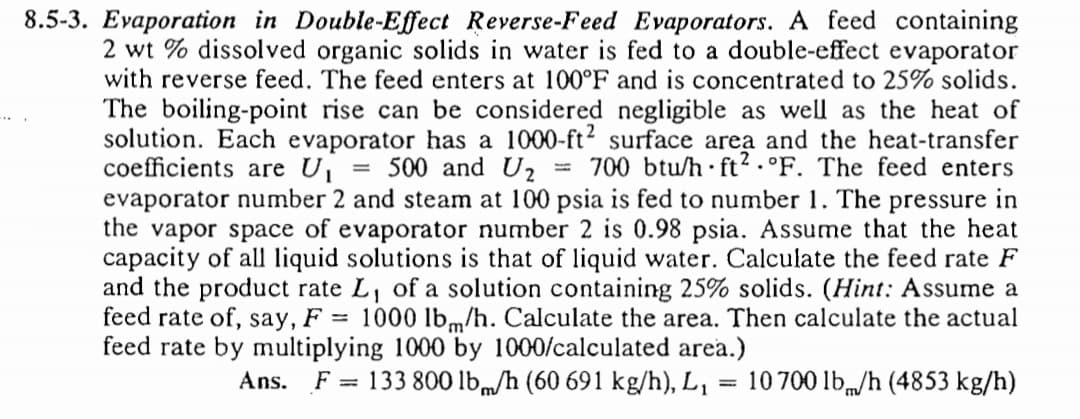Evaporation in Double-Effect Reverse-Feed Evaporators. A feed containing 2 wt % dissolved organic solids in water is fed to a double-effect evaporator with reverse feed. The feed enters at 100°F and is concentrated to 25% solids. The boiling-point rise can be considered negligible as well as the heat of solution. Each evaporator has a 1000-ft2 surface area and the heat-transfer coefficients are U, = evaporator number 2 and steam at 100 psia is fed to number 1. The pressure in the vapor space of evaporator number 2 is 0.98 psia. Assume that the heat capacity of all liquid solutions is that of liquid water. Calculate the feed rate F and the product rate L, of a solution containing 25% solids. (Hint: Assume a feed rate of, say, F = 1000 lb„/h. Calculate the area. Then calculate the actual feed rate by multiplying 1000 by 1000/calculated area.) 500 and Uz = 700 btu/h ft?.°F. The feed enters %D m Ans. F = 133 800 lbm/h (60 691 kg/h), L, 10 700 lb.„/h (4853 kg/h)
Evaporation in Double-Effect Reverse-Feed Evaporators. A feed containing 2 wt % dissolved organic solids in water is fed to a double-effect evaporator with reverse feed. The feed enters at 100°F and is concentrated to 25% solids. The boiling-point rise can be considered negligible as well as the heat of solution. Each evaporator has a 1000-ft2 surface area and the heat-transfer coefficients are U, = evaporator number 2 and steam at 100 psia is fed to number 1. The pressure in the vapor space of evaporator number 2 is 0.98 psia. Assume that the heat capacity of all liquid solutions is that of liquid water. Calculate the feed rate F and the product rate L, of a solution containing 25% solids. (Hint: Assume a feed rate of, say, F = 1000 lb„/h. Calculate the area. Then calculate the actual feed rate by multiplying 1000 by 1000/calculated area.) 500 and Uz = 700 btu/h ft?.°F. The feed enters %D m Ans. F = 133 800 lbm/h (60 691 kg/h), L, 10 700 lb.„/h (4853 kg/h)
Introduction to Chemical Engineering Thermodynamics
8th Edition
ISBN:9781259696527
Author:J.M. Smith Termodinamica en ingenieria quimica, Hendrick C Van Ness, Michael Abbott, Mark Swihart
Publisher:J.M. Smith Termodinamica en ingenieria quimica, Hendrick C Van Ness, Michael Abbott, Mark Swihart
Chapter1: Introduction
Section: Chapter Questions
Problem 1.1P
Related questions
Question

Transcribed Image Text:8.5-3. Evaporation in Double-Effect Reverse-Feed Evaporators. A feed containing
2 wt % dissolved organic solids in water is fed to a double-effect evaporator
with reverse feed. The feed enters at 100°F and is concentrated to 25% solids.
The boiling-point rise can be considered negligible as well as the heat of
solution. Each evaporator has a 1000-ft2 surface area and the heat-transfer
coefficients are U
evaporator number 2 and steam at 100 psia is fed to number 1. The pressure in
the vapor space of evaporator number 2 is 0.98 psia. Assume that the heat
capacity of all liquid solutions is that of liquid water. Calculate the feed rate F
and the product rate L, of a solution containing 25% solids. (Hint: Assume a
feed rate of, say, F = 1000 lbm/h. Calculate the area. Then calculate the actual
feed rate by multiplying 1000 by 1000/calculated area.)
= 500 and U2
= 700 btu/h•ft.°F. The feed enters
Ans.
F = 133 800 lb,m/h (60 691 kg/h), L,
10 700 lb„/h (4853 kg/h)
Expert Solution
This question has been solved!
Explore an expertly crafted, step-by-step solution for a thorough understanding of key concepts.
This is a popular solution!
Trending now
This is a popular solution!
Step by step
Solved in 4 steps with 1 images

Recommended textbooks for you

Introduction to Chemical Engineering Thermodynami…
Chemical Engineering
ISBN:
9781259696527
Author:
J.M. Smith Termodinamica en ingenieria quimica, Hendrick C Van Ness, Michael Abbott, Mark Swihart
Publisher:
McGraw-Hill Education

Elementary Principles of Chemical Processes, Bind…
Chemical Engineering
ISBN:
9781118431221
Author:
Richard M. Felder, Ronald W. Rousseau, Lisa G. Bullard
Publisher:
WILEY

Elements of Chemical Reaction Engineering (5th Ed…
Chemical Engineering
ISBN:
9780133887518
Author:
H. Scott Fogler
Publisher:
Prentice Hall

Introduction to Chemical Engineering Thermodynami…
Chemical Engineering
ISBN:
9781259696527
Author:
J.M. Smith Termodinamica en ingenieria quimica, Hendrick C Van Ness, Michael Abbott, Mark Swihart
Publisher:
McGraw-Hill Education

Elementary Principles of Chemical Processes, Bind…
Chemical Engineering
ISBN:
9781118431221
Author:
Richard M. Felder, Ronald W. Rousseau, Lisa G. Bullard
Publisher:
WILEY

Elements of Chemical Reaction Engineering (5th Ed…
Chemical Engineering
ISBN:
9780133887518
Author:
H. Scott Fogler
Publisher:
Prentice Hall


Industrial Plastics: Theory and Applications
Chemical Engineering
ISBN:
9781285061238
Author:
Lokensgard, Erik
Publisher:
Delmar Cengage Learning

Unit Operations of Chemical Engineering
Chemical Engineering
ISBN:
9780072848236
Author:
Warren McCabe, Julian C. Smith, Peter Harriott
Publisher:
McGraw-Hill Companies, The